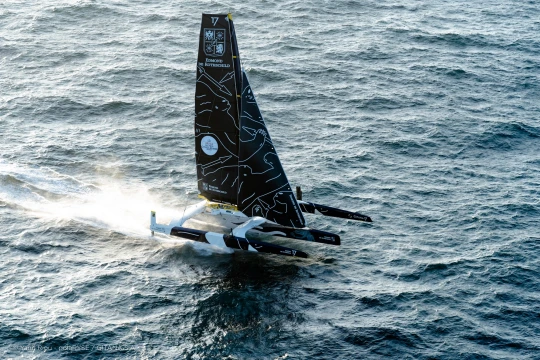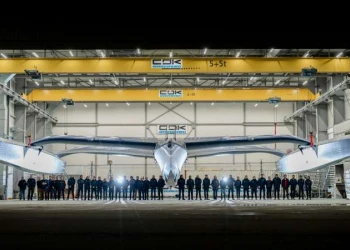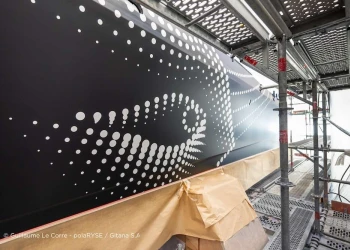
© Y.Riou / polaRYSE / GITANA S.A
The weather calls stoppage time on Caudrelier and the Maxi Edmond de Rothschild
For the past twenty-five days, Charles Caudrelier has kept plugging away to get the Maxi Edmond de Rothschild making headway as fast as possible. At the head of the Arkea Ultim Challenge fleet since 17 January, the sailor has been setting a very high pace and yesterday boasted a lead of over 3,500 miles ahead of his closest pursuers. However, yesterday evening, with the support of his routing cell, he took the decision to put his race on hold for a period yet to be determined. Indeed, the weather conditions expected this weekend around Cape Horn are proving to be completely incompatible with a passage of the famous rock located in Tierra del Fuego, at the far south of Latin America. A very wide low-pressure system resulting from a combination of two depressions, it is set to sweep across the zone in question rendering any sea passage perilous as violent winds – gusting from 50 to 70 knots – and very heavy seas are expected according to the forecasts.
A violent phenomenon blocking the way
The Southern Ocean is proving to be rather uncompromising with the competitors in the Arkea Ultim Challenge. Over the past few days, the solo sailors have had to contend with some difficult weather conditions. This is evidenced in the chasing pack where Armel Le Cléac'h has had to pass Tasmania via the Bass Strait and is now making headway on a course further north to round New Zealand and escape some very active low-pressure systems to his south. This unique course choice is obviously counterproductive in terms of performance and the competition, but it is an essential and responsible option in the quest to preserve both the man and the machine.
For more than three days, the Maxi Edmond de Rothschild's routing cell has also been monitoring the situation, albeit around the Horn, which was still some 1,800 miles away yesterday evening. The weather trio comprising Erwan Israël, Julien Villion and Benjamin Schwartz, have been running the routing software every time the latest models are issued. Last night, shortly before the cut-off point that they'd agreed with Charles Caudrelier, the decision was forced upon them, as Erwan Israël explained: "We've been biding our time to give ourselves every chance of success, hoping that the general situation would improve as the days went on. Contrary to that, it has deteriorated considerably. It was deemed completely out of the question to commit to a direct course towards the Horn with such a weather forecast. It would have been akin to an ambush, with the whole system closing in on us with no possible means of escape since to the south of us we're limited by the Antarctic Exclusion Zone. We're facing an austral low-pressure system on a NE'ly trajectory homing in on our present course. It is at 70° South for now. There is a second depression to the north of this first system. Over the coming days, these two systems will collide and merge, which will be explosive. This violent phenomenon is set to cross our path and it is on the same time scale. If we continue making headway as we are, we'll end up at the centre of this massive and very deep depression. On top of that, on the approach to Cape Horn with the Andes cordillera, the area is subject to the effects of massive compression and amplification."
A unanimous and shared decision
"Had we continued on our current course with a more classic weather forecast, our passage around Cape Horn was estimated to be this coming weekend. We would very likely have made our rounding on Sunday 4 February. Over that exact time scale, forecasts were giving winds bordering on 70 knots in the gusts and very heavy seas associated with that. Our decision, despite the obvious frustration, to put our race on hold and accept the resulting loss of time and miles, was unanimous and shared. It is the obvious choice in terms of safety and good seamanship," added Cyril Dardashti, Director of the Gitana racing stable.
The obligatory wait for the systems to roll through is not clearly defined as yet as the latter will naturally depend on how conditions develop on the approach to Cape Horn. However, it is already clear that it will amount to around ten hours or so.
Aboard the Maxi Edmond de Rothschild, Charles Caudrelier will put this precious time to good use. First up he will get some rest, but he will also carry out some work and some of the checks required by his shore team. Indeed, the members of Gitana Team have already prepared a checklist for him, which will be timely after over 18,000 miles covered at a brisk pace.
Charles Caudrelier, 2 February
"I knew that this race was going to be an adventure and I can confirm that that is certainly the case. Cape Horn won't let us pass for the moment! There's a massive depression lining up in front of us and together with my routers we've taken the decision to be patient. We have a good lead and we're going to try to preserve that as best we can. It's the first time in my life that a situation like this has happened to me whilst racing. It's very frustrating of course as Cape Horn is just there! If everything went to plan, I could be there in 2 days. However, it's also important to get things in perspective in relation to my playmates behind me, in relation to the weather, as well as the issues they've had. Me and my boat are in great shape. I'm still smiling and I'm remaining positive, even though I'm bound to be champing at the bit seeing the miles count down. Maybe being a week ahead was a lot, though that was what I was expecting here, but Cape Horn with a lead of more than a day is something any round the world sailor dreams of and I think I'll have more than that."





